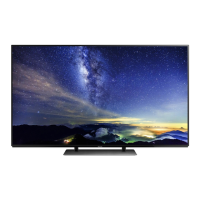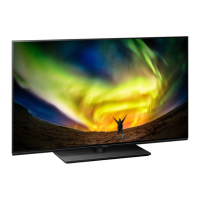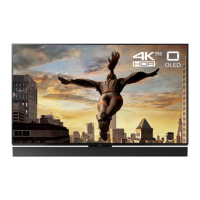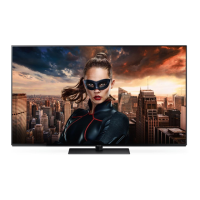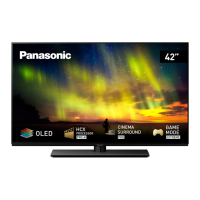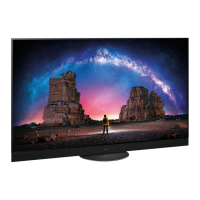Do you have a question about the Panasonic TX-65FZ802B and is the answer not in the manual?
Step-by-step guide on how to access TV programs, applications, and connected devices from Home.
Accessing various applications, including internet content, from the Apps menu on the TV.
Guides on selecting channels using the information banner, TV Guide, and manual tuning.
Choosing picture modes like Dynamic, Cinema, or Custom to suit viewing preferences and lighting conditions.
Manually changing the aspect ratio (image size) for optimal display across different content types.
Adjusting core picture parameters like Luminance, Contrast, Brightness, Colour, Tint, and Sharpness.
Detailed picture adjustments including Contrast Control, Colour Gamut, White Balance, and Gamma.
Choosing sound modes like Standard, Music, Speech, or Stadium to optimize audio for different content.
Managing volume output via Speaker Selection, TV Speaker Setting, Headphone Volume, and Auto Gain Control.
Setting timers to record future programs by selecting channel, date, start time, and end time.
Skipping unwanted channels, editing DVB/Analogue channels, and creating custom channel lists.
Preparing the USB HDD for exclusive use with the TV for recording and playback.
Recording the current TV program to the USB HDD immediately with a single button press.
Step-by-step guide on how to access TV programs, applications, and connected devices from Home.
Accessing various applications, including internet content, from the Apps menu on the TV.
Guides on selecting channels using the information banner, TV Guide, and manual tuning.
Choosing picture modes like Dynamic, Cinema, or Custom to suit viewing preferences and lighting conditions.
Manually changing the aspect ratio (image size) for optimal display across different content types.
Adjusting core picture parameters like Luminance, Contrast, Brightness, Colour, Tint, and Sharpness.
Detailed picture adjustments including Contrast Control, Colour Gamut, White Balance, and Gamma.
Choosing sound modes like Standard, Music, Speech, or Stadium to optimize audio for different content.
Managing volume output via Speaker Selection, TV Speaker Setting, Headphone Volume, and Auto Gain Control.
Setting timers to record future programs by selecting channel, date, start time, and end time.
Skipping unwanted channels, editing DVB/Analogue channels, and creating custom channel lists.
Preparing the USB HDD for exclusive use with the TV for recording and playback.
Recording the current TV program to the USB HDD immediately with a single button press.
| Package depth | 235 mm |
|---|---|
| Package width | 1837 mm |
| Package height | 945 mm |
| Package weight | 44000 g |
| Product color | Black |
| Panel mounting interface | 400 x 400 mm |
| PC in (D-Sub) | - |
| HDMI ports quantity | 4 |
| USB 2.0 ports quantity | 2 |
| Compatible memory cards | SD |
| Component video (YPbPr/YCbCr) in | 1 |
| Common interface Plus (CI+) version | 1.3 |
| Bluetooth version | 5.0 |
| Tuner type | Analog & digital |
| Digital signal format system | DVB-S, DVB-S2, DVB-T, DVB-T2 |
| Audio formats supported | AAC, FLAC, MP3, WAV, WMA |
| Image formats supported | JPEG |
| Video formats supported | 3GPP, AVI, FLV, HEVC, M4V, MKV, MP4, PS, TS, VOB, VRO, WMV |
| High Dynamic Range (HDR) technology | High Dynamic Range 10 (HDR10), High Dynamic Range 10+ (HDR10 Plus), Hybrid Log-Gamma (HLG) |
| AC input voltage | 220 - 240 V |
| AC input frequency | 50 - 60 Hz |
| Power consumption (off) | 0.3 W |
| Power consumption (standby) | 0.5 W |
| Power consumption (typical) | 158 W |
| Sound modes | Music, Speech, Standard |
| RMS rated power | 40 W |
| On Screen Display (OSD) languages | English |
| Screen shape | Flat |
| Response time | - ms |
| Display diagonal | 65 \ |
| Display brightness | - cd/m² |
| Display technology | OLED |
| Display diagonal (metric) | 164 cm |
| Dynamic contrast ratio marketing name | Ultimate Contrast |
| Smart modes | Cinema, Custom, Dynamic, Game, Normal, Sports, True Cinema |
| Depth (with stand) | 300 mm |
|---|---|
| Width (with stand) | 1449 mm |
| Height (with stand) | 898 mm |
| Weight (with stand) | 33500 g |
| Depth (without stand) | 62 mm |
| Height (without stand) | 837 mm |
| Weight (without stand) | 28000 g |

